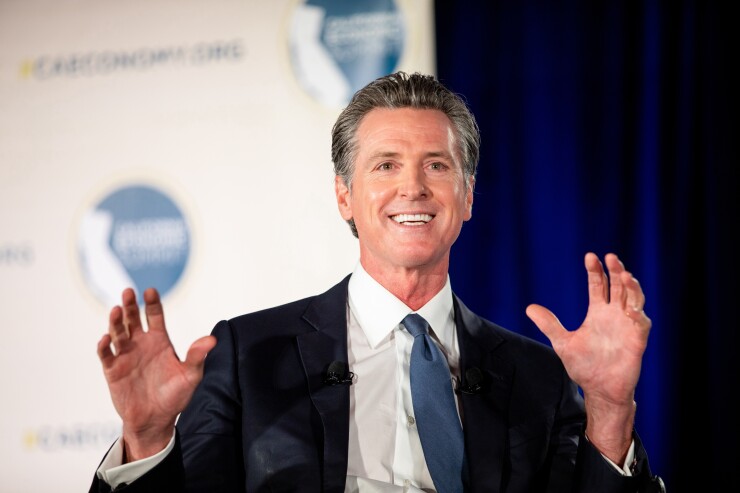California Gov. Gavin Newsom and legislative leaders have agreed on a $300 billion fiscal 2022-23 budget that includes a $17 billion taxpayer relief plan.
Newsom and fellow Democrats who lead both houses of the Legislature have been at
The governor had wanted to tie refunds more closely to gas tax relief and provide $400 payments through the Department of Motor Vehicles, while lawmakers wanted refunds that more clearly provided relief to low- and moderate-income residents.

The legislative leaders appear to have won the day.
“California’s budget addresses the state’s most pressing needs, and prioritizes getting dollars back into the pockets of millions of Californians who are grappling with global inflation and rising prices of everything from gas to groceries,” Newsom, Sen. President pro Tempore Toni Atkins, D-San Diego, and Assembly Speaker Rendon, D-Lakewood, said in a statement announcing the budget agreement Monday.
The $9.5 billion in the inflation relief package that will go directly to taxpayers more closely resembles what lawmakers had proposed than Newsom’s plan. The amount of relief to the poorest taxpayers has grown from the $200 originally proposed by lawmakers to $350.
The relief plan would provide payments of $350 per taxpayer, plus an additional $350 per dependent up to $1,050 for taxpayers who make less than $150,000 filing jointly, or $75,000 filing singly. It also offers second and third tiers of $250 refunds for taxpayers with incomes up to $125,000/$250,000 filing jointly or singly and $200 for taxpayers who make $250,000/$500,000 filing jointly or singly.
The $17 billion relief plan that includes the rebates outlined above, would also provide monthly grants totaling $470 for people receiving Social Security payments and $1.4 billion in utility assistance to pay down past-due bills accrued at the height of the pandemic. It also provides $2.3 billion in relief to small businesses and non-profits.
Though talks about gas tax and inflation have captured the most attention the budget also includes a massive infrastructure package that has grown from the $37 billion included in the governor’s May revise to a $47 billion, multi-year plan.
The infrastructure package includes a $14.8 billion transportation package split between mass transit, freight, transportation, and climate adaptation projects. It creates an independent Office of Inspector General for the high-speed rail project and appropriates the remaining $4.2 billion of Proposition 1A high-speed rail funds with legislative direction to prioritize construction of a Merced-Bakersfield segment.
Roughly $2 billion is earmarked for an affordable housing package. It allocates the remaining Proposition 51 bond funds, roughly $1.4 billion to support school construction projects and provides $4.2 billion from the general fund to supplement those bond funds through 2025. It provides $650 million over the next two years to build pre-school, transitional kindergarten and kindergarten facilities.
Universities receive $2 billion for student housing over the next two years. Another $2.7 billion goes for deferred maintenance and to support projects across the University of California and California State university systems.
The budget also provides $550 million for broadband infrastructure spread over two years and $6.1 billion for clean trucks, buses, cars and charging infrastructure.
A $19 billion multi-year climate-energy package completes the long list of infrastructure projects. It covers drought resilience, wildfire resilience, energy, and zero-emission vehicles, but adds the caveat that more details will be added later in the session alluding to trailer bills fleshing out more specific spending plans.
The budget has to be in print for three days before lawmakers can pass and Newsom can sign the bill just in time for the new fiscal year to begin July 1.
The state has a $97.5 billion surplus with $49.2 billion available for discretionary spending, according to Senate Bill/Assembly Bill 154.
Ratings analysts have been
The Legislature’s $300 billion spending plan would include total reserves of $37.8 billion, split between four reserve funds, nearly twice the $19 billion set aside in the 2019-20 budget.
“The near doubling of anticipated state reserves in the last three years demonstrates Legislative Democrats’ commitment to responsible budgeting, as well as the positive effects of the Proposition 2 rainy-day fund constitutional amendment, which was proposed by the Legislature and approved by voters in 2014,” according to the budget document.
According to initial estimates the state is $11 billion under the Gann Limit, a constitutional spending limit set by voters in 1978, for the two-year period ending on June 30, 2022, and $11 billion under the Gann Limit for the 2022 fiscal year, according to the budget.





